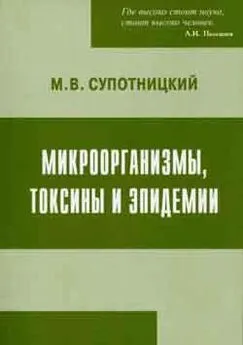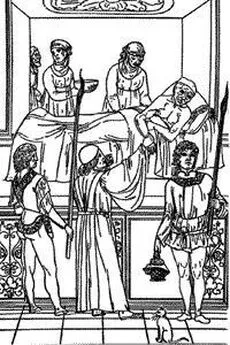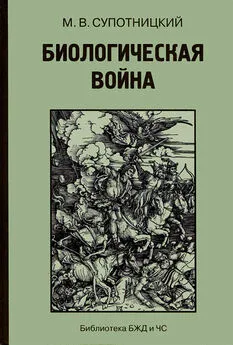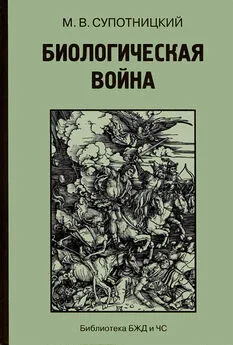Михаил Супотницкий - Микроорганизмы, токсины и эпидемии
- Название:Микроорганизмы, токсины и эпидемии
- Автор:
- Жанр:
- Издательство:Вузовская книга
- Год:2006
- Город:Москва
- ISBN:нет данных
- Рейтинг:
- Избранное:Добавить в избранное
-
Отзывы:
-
Ваша оценка:
Михаил Супотницкий - Микроорганизмы, токсины и эпидемии краткое содержание
Кроме того, в монографии, впервые для отечественной литературы, обстоятельно освещены эпидемиология биологического террористического акта и методология выявления такого преступления. Книга хорошо иллюстрирована, содержит приложения и рассчитана на широкий круг специалистов.
Микроорганизмы, токсины и эпидемии - читать онлайн бесплатно полную версию (весь текст целиком)
Интервал:
Закладка:
Супотницкий М.В. После СПИДа // Российский химический журнал. — 1996. — Т. XL, № 2. — С. 141–156.
Супотницкий М.В. «Природа не делает скачков» // Природа. — 1997. - № 8. — С. 67–77.
Супотницкий М.В., Тарасов М.Ю. Диверсионная версия вспышки сибирской язвы в г. Свердловске в 1979 г. // Диагностика, лечение и профилактика инфекционных заболеваний. Матер. юбил. науч. конф., посв. 50-летию ЦВТП БЗ НИИ микробиологии МО РФ. — Екатеринбург, 1999.
Таршис М.Г., Черкасский Б.Л. Болезни животных, опасные для человека. — М., 1997.
Тиолле П., Буэндиа М. Вирус гепатита В //В мире науки.—
1991.- № 8, С. 42–50.
Федоров Ю.Н., Верховский О.А. //Ветеринария. ‑1996. —
№ 10. -C.17–19.
Филдс Б., Найп Д., Ченок Р. и др. Вирусология: В 3 т. // Пер. с англ. под ред. Н.В. Каверина, Л.Л. Киселева. — М., 1989.
Шувалова Е.П. Тропические болезни. — М., 1973.
Хаитов Р.М., Пинегин Б.В. Основные представления о вторичных иммунодефицитных состояниях // Медикал маркет. — 1999. - № 1. — С. 6–9.
Эндрюс К. Естественная история вирусов. — М., 1969.
Яблоков А.В., Юсуфов А.Г. Эволюционное учение. — М., 1998.
Ягодинский В.Н. Динамика эпидемического процесса. — М., 1977.
Яркоан Р., Мицуя Х., Бродер С. Средства лечения СПИДа // В мире науки. — 1988. — N 12. — С. 78–88. Abel L., Dissein A. Genetic Epidemiology of Infectious Diseases in Humans: Design of Population-Based Studies // Emerging Infectious diseases. — 1998. — Vol. 4, № 4. — P. 593–603.
Ablin R. AIDS: Deja Vu in Ancient Egypt? // Emerging Infectious diseases. — 1996. — Vol. 3, № 2. — P. 242.
Acheson D., Keusch G. Whith Shiga toxin-producing types of E.coli are important? // ASM News. — 1996. — Vol. 62, № 6. — P. 302–306.
Adenike A., Pruscker J., Benson R. et al. / Legionella-Like Pathogens — Philogenetic Status and Possible Role in Respiratory Disease // Emerging Infectious diseases. — 1996. — Vol. 3, № 2. — P. 225–230.
Aktories K. Rho proteins: targets for bacterial toxins // Trends Microbiol. — 1997.- Vol.5, № 2. — P. 282–288.
Alcami A., Smith G. Receptors for gamma-interferon encoded by poxviruses: implications for the unknown origin of vaccinia virus // Trends in Microbiology. — 1996. — Vol. 4, № 8. — P. 321–326.
Alibek K., Handelman S. Biohazard. New York: Random House. — 1999.
Ampel N. Plague-What”s past is present:: Thorughts on the origin and history of new infectious diseases // Rev. Infect. Dis. — 1991. — Vol. 13, № 3. — P. 658–668.
Ampel N. Emerging Disease Issues and Fungal Pathogens Associated with HIV Infection // Emerging Infectious Diseases. — 1996. — Vol. 2, № 2. — P. 109–114.
Arnon S. Human tetanus and human botulism // In: Rood JI, McClane BA, Songer JG, Titball RW, editors. The clostridia: molecular biology and pathogenesis. San Diego: Academic Press; 1997. - P. 95–115.
Asjo B., Morfeldt-Manson L., Albert J. et al. Replicative capacity of human immunodeficiency virus from patients with varying severity of HIV infection // Lancet. - 1986. — Vol. 334, № 3. — P. 660–662.
Atlas R.M. Combating the Threat of Biowarfare and Bioterrorism // BioScience. — 1999. — Vol. 49, № 6. — P. 465–477.
Barg N.L., Hutson F., Wheeler L. et al. Novel Digidrofolate reductases Isolated from Epidemic Strains of Trimetoprim sulfametohoxazolle-resistant Shigella sonnei // J. Infect. Diseases. - 1990. — Vol. 162, № 2. — P. 466–473.
Baseman J., Tully J. Mycoplasmas: Sophisticated, Reemerging, and Burdened by Their Notoriety // Emerging Infectious Diseases. — 1997. — Vol. 3, № 1. — P. 21–33.
Baum R. Progress fitful on understanding AIDS, developing therapies //Chem. and Eng. News.-1992.- Vol. 70, № 34.- P.26–30.
Bayerdorffer E., Neubauer A., Rodolph B. et al. Regression of primary gastric lymphoma of mucosa-associated lymphoid tissue type after cure of Helicobacter pylori infection // Lancet. — 1995. — Vol. 345. — P. 1591–1595.
Bennett R. Diarrhea among residents of long-term care facilities // Infect Control Hosp Epidemiol. — 1993. — Vol. 14, № 2. — P. 397–404.
Bell D. Forces that have helped shape the U.S. egg industry: the last 100 years. Poultry Tribune. — 1995. — P. 30–43.
Biberfeld G. Infection sequelae and autoimmune reactions in Mycoplasma pneumoniae infection // In: Razin S, Barile MF, ed. The Mycoplasmas. - Vol. IV. New York: Academic Press, 1985. — P. 293–311.
Bhakdi S., Tranum-Jensen J. Alpha-toxin of Staphylococcus aureus // Microbiological Reviews. — 1991. — Vol. 55, № 3. — P. 733–751.
Bhakdi S., Bayley H., Valeva A. et al. Staphylococcal alpha-toxin, streptolysin-O and Escherichia coli hemolysin: prototypes of pore-forming bacterial cytolysins // Arch. Microbiol. — 1996. — Vol. 165, № 1. — P. 73–79.
Blum G., Falbo V., Caprioli A. et al. Gene clusters encoding the cytotoxic necrotizing factor type 1, Prs-fimbriae and — hemolysin form the pathogenicity island II of the uropathogenic Escherichia coli strain J96 // FEMS Microbiol. Lett. — 1995. — Vol. 126, № 1. - P. 189–196.
Branck M. Agents transmissible from simians to man. — Berlin, 1987.
Bryan L. Mechanisms of plasmid mediated drug resistance // Plasmids and Transposons. — N.Y., 1980. — P. 51–81.
Buckley R. Primary immunodeficiency diseases // In: Bennett JC, Plum F, editors. Cecil textbook of medicine. Philadelphia: W.B. Saunders Company; 1996. - P. 1401–1408.
Calisher C., Sever J. Are North American Bunyamwera Serogroup Viruses Etiologic Agents of Human Congenital Defects of the Central Nervous System? // Emerging Infectious Diseases. — 1995. — Vol. 1, № 4. — P. 147–152.
Carri R., Fermi C., Alexander S. // Заявка WO 91/1809, международная, C12 № 7/00, 1992 (США).
Cassel G.H. Infectious Causes of Chronic Inflammatory Diseases and Cancer // Emerging Infectious Diseases. — 1998. — Vol. 4, № 3. — P. 475–486.
Champion H., Bennett P., Levis D. et al. Cloning and characterization of an AAC (6”) gene from Serratia marcescens // Antimicrob. Chemother. — 1983. — Vol. 22, № 5. — P. 587–596.
Chaudhry R., Dhawan B., Kumar D. et al. Outbreak of suspected Clostridium butyricum botulism in Lndia // Emerging Infectious Diseases. — 1998. — Vol. 4, № 3. — P. 506–507.
Cichutek K. // AIDS-Forsch. — 1992. —Vol.7, № 11.P.595—.
Cocchi F., DeVico A., Garzine-Demo A. et al. Identification of RANTES, MIP-1a and MIPЯ as the major HIV-suppressive factors produced by CD8+ T cells // Science. — 1995. — Vol. 270. — P. 1811–1815.
Coffin J. Genetic diversity and evolution of retroviruses // Curr. Top. Microbiol. Immunol. — 1992. Vol. 176, № 1. — P. 143–64.
Cohen J.// Science. — 1992.- Vol.257, № 5069. — P.478.
Cohen J. Is an old virus up to new tricks // Science. — 1997. — Vol. 277, № 5324. — P. 312–313.
Collins J., Small M., Kann L. et al. School health education // J. Sch. Health. — 1995. — Vol. 65, № 2. — P. 302–311.
Cornelis G. Yersinia Pathogenicity Factors. In: Hormaeche CE, Penn CW, Smyth CJ, editors. Molecular Biology of Bacterial Infection: Current Status and Future Perspectives. Cambridge: Cambridge University Press., 1992.
Craven R., Eliason D., Francy P. et al. Importation of Aedes albopictus and other exotic mosquito species into the United States in used tires from Asia // J. Am. Mosq. Control. Assoc. — 1988. — Vol. 4, № 1. — P. 138–142.
Crowle A.J., Cochn D.L., Poche P. Defects in sera from AIDS patients and from non-AIDS patients with Mycobacterium avium infection which decreases macrophage resistance to M.avium // Infect. Immun. — 1991. — Vol. 57,№ 7. — P. 1445–1451.
Cunningham M. Molecular mimicry: bacterial antigen mimicry // In. Bona C., Siminovitch K., Theofilopoulos A., Zanetti M., editors. The pathology of autoimmunity. New York: Harwood Academic Publishers, 1993. — P. 245–256.
Davenport M., Quinn C., Chicz R. et al. Naturally processed peptides from two disease resistance associated HLA-DR13 alleles show related sequence motifs andeffects of the dimorphism at position 86 of the HLA-DR beta chain // Proc. Natl. Acad. Sci. — 1995. — Vol. 92, № 8. — P. 6567–6571.
Denis M. Envelope glycoprotein (gp120) from HIV-1 enhances Mycobacterium avium growth in human bronchoalveolar macrophages // Clin. and Exp. Immunol. — 1994. — Vol. 98, № 1. — P. 123–127.
DePaola A., Capers G., Moters M. et al. Isolation of Latin American epidemic strain of Vibrio cholerae O1 from US Gulf Coast // Lancet. — 1992. — Vol. 339, № 5. — P. 624.
Delden C.V., Iglewski B.H. Cell-to-Cell Signaling and Pseudomonas aeruginosa Infections // Emerging Infectious diseases. — 1998. — Vol. 4, № 4. — P. 551–559.
Dimond P.F.// Bio/Technology. — 1990. —Vol.8, № 8.- P. 707–708.
Douglas J., Soike K., Raynor J. The incidence of poliovirus in chimpanzees (Pan troglodytes) // Laboratory Animal Care. — 1970. — Vol. 20, № 2. — P. 265–268.
Eisner R. HIV discoverer in mycoplasma controversy // Bio Technology. — 1990. — Vol. 8, № 8. — P. 10.
Epstein P., Ford T., Colwell R. Marine ecosystems // Lancet. — 1994. — Vol. 343, № 1. — P. 115–116.
Eradication de la variole. Repport d' un Groupe scientifique de l'OMS/ — Geneva, 1968. — P. 393.
Escalante A.A., Wolfe N., Karesh W. et al. Wild Primate Populations in Emerging Infectious Disease Research: The Missing Link? // Emerging Infectious Diseases. — 1998. - Vol.4, № 1. — P. 22–45.
Ewald P. Host-parasite relation, vector, and the evolution of disease severity // Annual Review of Ecology and Systematics. — 1984. — Vol. 14, №. 2 — P. 465–485.
Ewald P. Evolution of Infectious Disease. — N.Y., 1994.
Falbo V., Pace T., Picci L. et al. Isolation and nucleotide sequence of the gene encoding cytotoxic necrotizing factor 1 of Escherichia coli // Infect Immun. — 1993. — Vol. 61, № 12. — P. 4909–4914.
Fernandez-Reyes D, Craig A., Kyes S. et al. A high frequency African coding polymorphism in the N-terminal domain of ICAM-1 predisposing to cerebral malaria in Kenya // Hum. Mol. Genet. — 1997. — Vol. 6. — P. 1357–1360.
Fetherston J., Schuetze P, Perry R. Loss of the pigmentation phenotype in Yersinia pestis is due to the spontaneous deletion of 102 kb of chromosomal DNA which is flanked by a repetitive. element // Mol. Microbiol. — 1992. — Vol. 6, № 13. — P. 2693–26704.
Finlay B, Falkow S. Common themes in microbial pathogenicity // Microbiol Rev. — 1989. — Vol.53, № 2. — P. 210–230.
Finlay B., Falkow S. Common Themes in Microbial Pathogenicity Revisited // Microbiology and Molecular Biology Reviews. — 1997. — Vol. 61, № 2. — P. 136–169.
Franz D.R., Jahring P.B., Friedlander A.M. et al.Clinical recognition and management of patiensts exposed to biological warfare agents // JAMA.- 1997. — Vol. 278, № 5. — P. 399–411.
Читать дальшеИнтервал:
Закладка:






![Михаил Супотницкий - Очерки истории чумы. Книга II. Чума бактериологического периода [без иллюстраций]](/books/1084186/mihail-supotnickij-ocherki-istorii-chumy-kniga-ii.webp)
![Михаил Супотницкий - Очерки истории чумы. Книга I. Чума добактериологического периода [без иллюстраций]](/books/1084187/mihail-supotnickij-ocherki-istorii-chumy-kniga-i-ch.webp)


